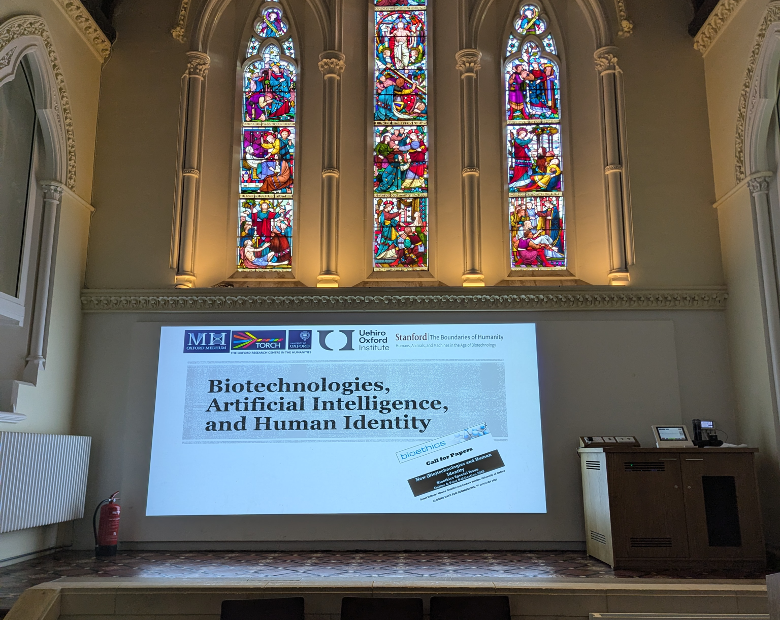Andrew Moeller, Faculty of History
Alberto Giubilini, Uehiro Oxford Institute
Themes from the conference “Biotechnology, Artificial Intelligence, and Human Identity” (Medical Humanities Programme)
Crossposted from TORCH Medical Humanities
The conference “Biotechnologies, Artificial Intelligence, and Human Identity” brought together a crowded room to hear 12 speakers engage in lively discussion on whether and how technologies such as genomic interventions, artificial intelligence, and brain-computer interfaces challenge our sense of who we are as humans. The event was co-sponsored by TORCH, the Uehiro Oxford Institute, and the Boundaries of Humanity Project (Stanford), and organized as part of the TORCH Medical Humanities Hub Programme.
Drawing from disciplines including history, philosophy, theology, medicine, linguistic, sociology, and literature, the conference was an opportunity to reflect on what it is to be human and how shared aspects of our humanity might help shape personal, societal, and governmental positions on the right uses of new (bio)technologies. Not only do these technologies often come with the promise of revolutionizing defining aspects of being human – from health to ageing, from intimate relationships to our conscious experiences. The language we use to refer to them is also imbued with metaphors deploying eminently human dimensions, such as when we talk of artificial intelligence’s autonomy, responsibility, or awareness. This prompts us to reflect on what these terms mean in the first place, as referred to humans.
Conference speakers addressed topics ranging from how sex robots shape our own self-understanding and aims in life, to the merging of the human with a brain-computer interface, to the feasibility and desirability of life extension.
It would be an injustice to all of the wide-ranging talks to attempt to summarize them here. Instead, we want to offer some high level-reflections on the conference.
First, some of the technologies we discussed have the potential to shape humanity itself in the distant future, for instance in the case of germline genome editing, where genetic modifications are passed down on to future generations. Therefore, they might grant us vast powers to reshape our shared human nature. However, when placed into the conceptual framework of the conference, reflections on human identity and related ones on human nature, the place of human beings in the natural order, and attending conceptions of flourishing are immediately relevant and often readily intelligible. Hence, those considerations can clearly reflect what is at stake with these new technologies for families, communities, and policy makers. Furthermore, the broad consideration of human identity can foster productive dialogue—as it is a topic from which we can readily learn from one another.
Second, the question of human identity is perhaps inexhaustible, and so at times might feel too broad. Yet, the conference did indicate the fruitfulness of bridging empirical and existential considerations when exploring this question. For example, how radical life extension might have an impact on the way we give meaning to our own lives and to the world is an intriguing line of inquiry. It’s not uncommon in this area to read about what life would be like when living to 500. However, as one speaker claimed, the biological possibilities of living to 500 years old appear scant at the moment and for the foreseeable future. We could frame this as a limitation, of course. But, more interestingly, we could instead take such scant prospect as an opportunity for reflection on the existential meaning of our own shorter lifespan and therefore the more pervasive sense of mortality we live with. Is the perception of mortality central to what it means to be human?
A final reflection relates to what might be termed the importance of quotidian existence. In his 1960 novel Life and Fate, Vassily Grossman reflected on the horrors of the 1930s and 1940s, while at the same time anticipating future technological advances. In doing so, he was reminding us of the significance of human beings. He asked: “Is there any limit to progress, to its ability to create machines in the image and likeness of man? … Is there a limit to its perfection? Can it be compared to man? Will it surpass him?”
Grossman then went to say this: “Childhood memories . . . tears of happiness . . . the bitterness of parting . . .love of freedom . . . feelings of pity for a sick puppy . . . nervousness . . . a mother’s tenderness . . . thoughts of death . . . sadness . . . friendship . . . love of the weak . . . sudden hope . . . a fortunate guess . . . melancholy . . . unreasoning joy . . . sudden embarrassment . . . The machine will be able to recreate all of this! But the surface of the whole earth will be too small to accommodate this machine – this machine whose dimensions and weight will continually increase as it attempts to reproduce the peculiarities of mind and soul of an average, inconspicuous human being.”
In any discussion on human identity, we should not forget that an ordinary human life is a good thing, and part of the point of this conference was precisely to keep the focus on the human amidst (bio)technological revolutions or promises thereof.
The themes of the conference will be explored in a special issue of the journal Bioethics, co-edited by Alberto and Andrew, with submissions welcome from anyone regardless of conference attendance. Deadline 7 Jan 2025, call for papers can be found here https://onlinelibrary.wiley.com/pb-assets/assets/14678519/cfp/CFP-New-Biotechs-1713252866743.pdf, for info please contact alberto.giubilini@uehiro.ox.ac.uk

